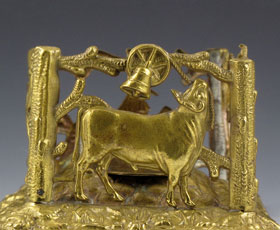Cock Robin's Grave

Needle Case

Needle Case

Design Representation
Design Details
Needle Case Type: |
Figural |
Patent/Registered to: |
W. Avery & Son - Redditch |
Patent/Design Representation #: |
Ornamental Class1: Metal: #352929 |
Patent/Design Registration Date: |
July 28, 1880 |
Location of Patent/Design Registration: |
The National Archives (TNA) - Kew, UK |
Reference #: |
TNA Representation - BT 43/47/352929
TNA Register - BT 44/4/352929 |
Dimensions: |
5.2 x 7.5 x 3.3 |
Material: |
Brass |
Name Variations: |
W. Avery & Son - Redditch |
Other Variations: |
a) Plain bottom
b) Bottom with two side clips |
Additional Photographs


Long side detailed views


Short side detailed views


Top closed and open


Plain bottom closed and open


Bottom with two side clips closed and open (photographs from eBay)


Bottom with two side clips detail views closed and open (photographs from eBay)


Interior with water color or chromolithographic print of bird (left photograph from eBay and right photograph courtesy of Keith James)


Interior with water color or chromolithographic print of bird (left photograph from eBay and right photograph courtesy of Keith James)
Note: to date only three examples have been found with the color print of the bird in the grave and they are almost identical which seems to
indicate this is an original part of this needle case. The third example is photographed in Horowitz and Mann's book "Victorian Brass
Needlecases,".
Facts
“Who killed Cock Robin” is an English nursery rhyme that was first published in the 1744. It became very popular during the Victorian
Era when a number of illustrated versions were published.

The Rhyme
Who killed Cock Robin?
I, said the Sparrow,with my bow and arrow,
I killed Cock Robin.
Who saw him die?
I, said the Fly,
with my little eye,
I saw him die.
Who caught his blood?
I, said the Fish,
with my little dish,
I caught his blood.
Who'll make the shroud?
I, said the Beetle,
with my thread and needle,
I'll make the shroud.
Who'll dig his grave?
I, said the Owl,
with my pick and shovel,
I'll dig his grave.
Who'll be the parson?
I, said the Rook,
with my little book,
I'll be the parson.
Who'll be the clerk?
I, said the Lark,
if it's not in the dark,
I'll be the clerk.
Who'll carry the link?
I, said the Linnet,
I'll fetch it in a minute,
I'll carry the link.
Who'll be chief mourner?
I, said the Dove,
I mourn for my love,
I'll be chief mourner.
Who'll carry the coffin?
I, said the Kite,
if it's not through the night,
I'll carry the coffin.
Who'll bear the pall?
We, said the Wren,
both the cock and the hen,
We'll bear the pall.
Who'll sing a psalm?
I, said the Thrush,
as she sat on a bush,
I'll sing a psalm.
Who'll toll the bell?
I said the Bull,
because I can pull,
I'll toll the bell.
All the birds of the air
fell a-sighing and a-sobbing,
when they heard the bell toll
for poor Cock Robin.
Click on the photograph below to see a larger copy of this picture of Walter Potter's version of Cock Robin's Grave.

Miscellaneous
One of the most famous depictions of the Death of Cock Robin was created by the infamous Victorian taxidermist Walter Potter. It
contained 98 species of British birds and was first shown to the public in 1861. Potter’s Museum of Curiosities, located in Sussex, was
renowned for its collection of Victorian oddities and was very popular with the Victorians. Unfortunately the museum closed in the late
20th century and the collection was sold in 2003. To see a larger version of Potter's creation, click on the photograph below.



























